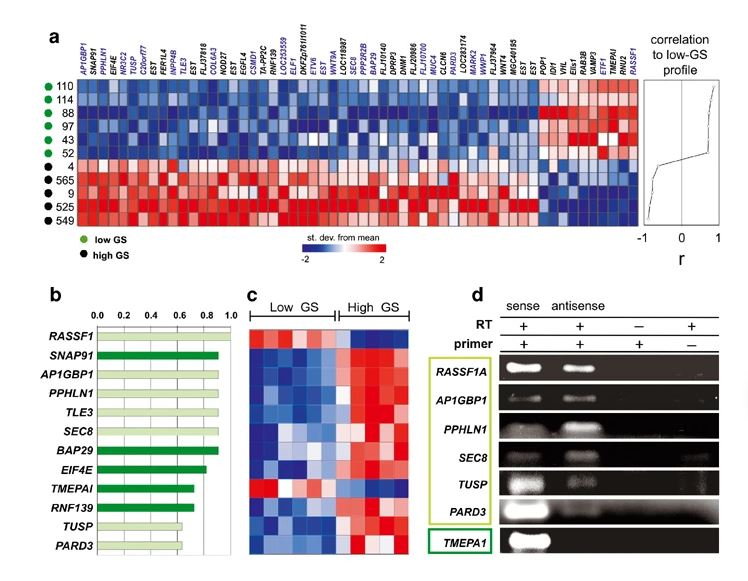Antisense intronic non-coding RNA levels correlate to the degree of tumor differentiation in prostate cancer.
A large fraction of transcripts are expressed antisense to introns of known genes in the human genome. Here we show the construction and use of a cDNA microarray platform enriched in intronic transcripts to assess their biological relevance in pathological conditions. To validate the approach, prostate cancer was used as a model, and 27 patient tumor samples with Gleason scores ranging from 5 to 10 were analyzed. We find that a considerably higher fraction (6.6%, [23/346]) of intronic transcripts are significantly correlated (P< or =0.001) to the degree of prostate tumor differentiation (Gleason score) when compared to transcripts from unannotated genomic regions (1%, [6/539]) or from exons of known genes (2%, [27/1369]). Among the top twelve transcripts most correlated to tumor differentiation, six are antisense intronic messages as shown by orientation-specific RT-PCR or Northern blot analysis with strand-specific riboprobe. Orientation-specific real-time RT-PCR with six tumor samples, confirmed the correlation (P=0.024) between the low/high degrees of tumor differentiation and antisense intronic RASSF1 transcript levels. The need to use intron arrays to reveal the transcriptome profile of antisense intronic RNA in cancer has clearly emerged.
Authors
Eduardo M Reis; Helder I Nakaya; Rodrigo Louro; Flavio C Canavez; Aurea V F Flatschart; Giulliana T Almeida; Camila M Egidio; Apuã C Paquola; Abimael A Machado; Fernanda Festa; Denise Yamamoto; Renato Alvarenga; Camille C da Silva; Glauber C Brito; Sérgio D Simon; Carlos A Moreira-Filho; Katia R Leite; Luiz H Camara-Lopes; Franz S Campos; Etel Gimba; Giselle M Vignal; Hamza El-Dorry; Mari C Sogayar; Marcello A Barcinski; Aline M da Silva; Sergio Verjovski-Almeida
External link
Publication Year
Publication Journal
Associeted Project
Long Noncoding RNAs
Lista de serviços
-
Genomic analyses reveal broad impact of miR-137 on genes associated with malignant transformation and neuronal differentiation in glioblastoma cells.Genomic analyses reveal broad impact of miR-137 on genes associated with malignant transformation and neuronal differentiation in glioblastoma cells.
-
RNA-Binding Protein Musashi1 Is a Central Regulator of Adhesion Pathways in Glioblastoma.RNA-Binding Protein Musashi1 Is a Central Regulator of Adhesion Pathways in Glioblastoma.
-
MicroRNA Transcriptome Profiling in Heart of Trypanosoma cruzi-Infected Mice: Parasitological and Cardiological Outcomes.MicroRNA Transcriptome Profiling in Heart of Trypanosoma cruzi-Infected Mice: Parasitological and Cardiological Outcomes.
-
Genome mapping and expression analyses of human intronic noncoding RNAs reveal tissue-specific patterns and enrichment in genes related to regulation of transcription.Genome mapping and expression analyses of human intronic noncoding RNAs reveal tissue-specific patterns and enrichment in genes related to regulation of transcription.
-
Antimicrobial peptide LL-37 participates in the transcriptional regulation of melanoma cells.Antimicrobial peptide LL-37 participates in the transcriptional regulation of melanoma cells.
-
Down-regulation of 14q32-encoded miRNAs and tumor suppressor role for miR-654-3p in papillary thyroid cancer.Down-regulation of 14q32-encoded miRNAs and tumor suppressor role for miR-654-3p in papillary thyroid cancer.
-
Integration of miRNA and gene expression profiles suggest a role for miRNAs in the pathobiological processes of acute Trypanosoma cruzi infection.Integration of miRNA and gene expression profiles suggest a role for miRNAs in the pathobiological processes of acute Trypanosoma cruzi infection.
-
Integrative Biology Approaches Applied to Human DiseasesIntegrative Biology Approaches Applied to Human Diseases
-
Proteomics reveals disturbances in the immune response and energy metabolism of monocytes from patients with septic shock.Proteomics reveals disturbances in the immune response and energy metabolism of monocytes from patients with septic shock.
-
Genomics, epigenomics and pharmacogenomics of Familial Hypercholesterolemia (FHBGEP): A study protocol.Genomics, epigenomics and pharmacogenomics of Familial Hypercholesterolemia (FHBGEP): A study protocol.
-
Melatonin-Index as a biomarker for predicting the distribution of presymptomatic and asymptomatic SARS-CoV-2 carriersMelatonin-Index as a biomarker for predicting the distribution of presymptomatic and asymptomatic SARS-CoV-2 carriers
-
Profiling plasma-extracellular vesicle proteins and microRNAs in diabetes onset in middle-aged male participants in the ELSA-Brasil study.Profiling plasma-extracellular vesicle proteins and microRNAs in diabetes onset in middle-aged male participants in the ELSA-Brasil study.
-
Big Data and machine learning in cancer theranosticsBig Data and machine learning in cancer theranostics
-
Genomic positional conservation identifies topological anchor point RNAs linked to developmental loci.Genomic positional conservation identifies topological anchor point RNAs linked to developmental loci.
-
Integrative systems immunology uncovers molecular networks of the cell cycle that stratify COVID-19 severityIntegrative systems immunology uncovers molecular networks of the cell cycle that stratify COVID-19 severity

